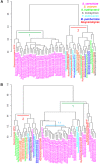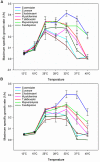Improving the Cryotolerance of Wine Yeast by Interspecific Hybridization in the Genus Saccharomyces
- PMID: 30671041
- PMCID: PMC6331415
- DOI: 10.3389/fmicb.2018.03232
Improving the Cryotolerance of Wine Yeast by Interspecific Hybridization in the Genus Saccharomyces
Abstract
Fermentations carried out at low temperatures (10-15°C) enhance the production and retention of flavor volatiles, but also increase the chances of slowing or arresting the process. Notwithstanding, as Saccharomyces cerevisiae is the main species responsible for alcoholic fermentation, other species of the genus Saccharomyces, such as cryophilic species Saccharomyces eubayanus, Saccharomyces kudriavzevii and Saccharomyces uvarum, are better adapted to low-temperature fermentations during winemaking. In this work, a Saccharomyces cerevisiae × S. uvarum hybrid was constructed to improve the enological features of a wine S. cerevisiae strain at low temperature. Fermentations of white grape musts were performed, and the phenotypic differences between parental and hybrid strains under different temperature conditions were examined. This work demonstrates that hybridization constitutes an effective approach to obtain yeast strains with desirable physiological features, like low-temperature fermentation capacity, which genetically depend on the expression of numerous genes (polygenic character). As this interspecific hybridization approach is not considered a GMO, the genetically improved strains can be quickly transferred to the wine industry.
Keywords: Saccharomyces cerevisiae; Saccharomyces uvarum; hybrids; low temperature; must fermentation; winemaking.
Figures





References
-
- Alonso del Real J., Lairón-Peris M., Barrio E., Querol A. (2017). Effect of temperature on the prevalence of Saccharomyces non cerevisiae Species against a S. cerevisiae wine strain in wine fermentation: competition, physiological fitness, and influence in final wine composition. Front. Microbiol. 8:150. 10.3389/fmicb.2017.00150 - DOI - PMC - PubMed
LinkOut - more resources
Full Text Sources
Molecular Biology Databases
Research Materials

